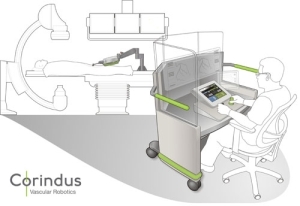by
Brendon Nafziger, DOTmed News Associate Editor | April 21, 2011

Artist's rendering
of the Corindus system.
(Photo courtesy
Corindus)
Robots are helping doctors
remove prostates, deliver anesthetics and
intubate sedated patients. Now, they might help them place stents.
Royal Philips Electronics said Thursday it bought a minority stake in privately held Corindus Vascular Robotics, a startup that makes an experimental robot for placing stents, balloon catheters and coronary guidewires. The Dutch electronics giant did not disclose terms of the deal.
While stents and X-ray machines have advanced in the past three decades, "the procedural process itself has remained largely unchanged," said David Handler, president and CEO of the Natick, Mass.-based Corindus, in a statement.



Ad Statistics
Times Displayed: 1581
Times Visited: 8 Keep biomedical devices ready to go, so care teams can be ready to care for patients. GE HealthCare’s ReadySee™ helps overcome frustrations due to lack of network and device visibility, manual troubleshooting, and downtime.
His company hopes his new device, the CorPath 200 System, changes all that. The system lets the doctor sit in a cockpit and remotely control a stent-placing robot. In its marketing materials, Corindus says the system might be able to improve visualization and minimize physician fatigue. Corindus also expects the lead-lined cockpit will reduce the doctor's exposure to radiation during interventional procedures.
The company hopes to wrap up its CorPath PRECISE trial, which just enrolled its first patients, in July. The Phase II trial, expected to enroll 175 patients by the end, will be the basis for the company's Food and Drug Administration 510(k) application. According to information filed with clinicaltrials.gov, the trial looks to see how safely the device can perform percutaneous coronary intervention procedures and whether it can reduce radiation exposure to the operator.

